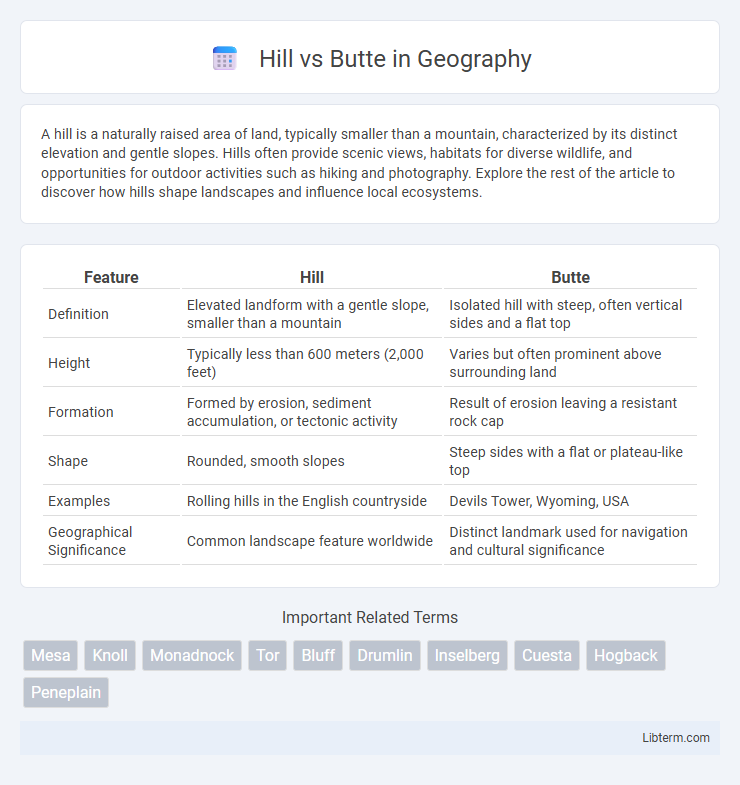A hill is a naturally raised area of land, typically smaller than a mountain, characterized by its distinct elevation and gentle slopes. Hills often provide scenic views, habitats for diverse wildlife, and opportunities for outdoor activities such as hiking and photography. Explore the rest of the article to discover how hills shape landscapes and influence local ecosystems.
Table of Comparison
| Feature | Hill | Butte |
|---|---|---|
| Definition | Elevated landform with a gentle slope, smaller than a mountain | Isolated hill with steep, often vertical sides and a flat top |
| Height | Typically less than 600 meters (2,000 feet) | Varies but often prominent above surrounding land |
| Formation | Formed by erosion, sediment accumulation, or tectonic activity | Result of erosion leaving a resistant rock cap |
| Shape | Rounded, smooth slopes | Steep sides with a flat or plateau-like top |
| Examples | Rolling hills in the English countryside | Devils Tower, Wyoming, USA |
| Geographical Significance | Common landscape feature worldwide | Distinct landmark used for navigation and cultural significance |
Introduction: Understanding Landform Differences
Hills and buttes are both elevated landforms, with hills characterized by their gentle slopes and rounded tops, typically covering larger areas. Buttes are more distinct, featuring steep, often vertical sides and a flat top resulting from erosion-resistant rock layers, making them smaller and more isolated than hills. Recognizing these differences aids in comprehending geological processes and landform classification.
Defining Hills: Characteristics and Formation
Hills are elevated landforms with gentle slopes, typically ranging from 100 to 600 meters in height, formed by processes such as erosion, sediment deposition, and tectonic activity. Their rounded tops and gradual inclines distinguish them from mountains and other landforms. Soil composition and vegetation coverage on hills often vary due to their formation history and local climate conditions.
What is a Butte? Key Features and Formation
A butte is an isolated hill with steep, often vertical sides and a small, flat top, typically smaller than mesas or plateaus. Key features include its sharply defined edges, resistant rock cap protecting the underlying softer layers, and its prominence in arid regions. Buttes form through erosion processes where wind and water wear away surrounding softer rock, leaving the harder rock standing as a distinct landform.
Geological Processes Behind Hills and Buttes
Hills and buttes form through distinct geological processes shaped by erosion and weathering. Hills are typically created by the gradual accumulation and uplift of sedimentary layers, often shaped by tectonic forces and surface runoff, leading to smoother, less steep landforms. Buttes result from the erosion of plateau remnants, where harder rock layers resist weathering, leaving isolated, steep-sided elevated features with flat tops.
Size and Shape: Hill vs Butte Comparison
A hill is a naturally raised area of land, typically larger and more rounded in shape, often with gentle slopes and elevations below 1,000 feet. In contrast, a butte is a smaller, isolated hill with steep, often vertical sides and a flat or nearly flat top, formed by erosion, and is significantly more abrupt in appearance. While hills can spread over wider areas, buttes are characterized by their compact size and dramatic vertical relief.
Geographic Distribution of Hills and Buttes
Hills typically form in regions with gradual tectonic uplift or erosional remnants, common in areas like the Appalachian Mountains and rolling terrains worldwide. Buttes, characterized by steep, isolated hills with flat tops, predominantly occur in arid to semi-arid regions such as the Colorado Plateau and the Great Plains of the United States. The geographic distribution of hills spans diverse climates and elevations, while buttes are concentrated in environments with significant erosion and sedimentary rock layers.
Ecological Importance of Each Landform
Hills provide critical habitats for diverse plant and animal species, contributing to soil conservation and water runoff regulation, which supports local ecosystems. Buttes serve as isolated ecological refuges, often harboring unique flora and fauna adapted to their rocky, elevated environments. Both landforms play vital roles in maintaining biodiversity and sustaining ecological balance within their respective landscapes.
Cultural Significance and Historical References
Hill and Butte hold deep cultural significance as landmarks central to regional heritage and Indigenous traditions, often serving as sacred sites and symbols of community identity. Historical references highlight their roles in mining booms and westward expansion, with Butte famously recognized for its copper mining history shaping local economies and labor movements. Both sites continue to influence cultural narratives and tourism, preserving stories integral to understanding American industrial and Native histories.
Hill and Butte Examples Around the World
Hills and buttes are prominent landforms distinguished by their size and slope, with hills being gently sloped elevations and buttes featuring steep, often vertical sides with a flat top. Famous hill examples include the Rolling Hills of the English countryside and Chapada Diamantina in Brazil, known for their smooth contours and scenic vistas. Iconic buttes such as Monument Valley's iconic Mittens in the United States and the Uluru in Australia showcase steep sides and isolated flat summits, illustrating the dramatic geological formations distinct to buttes worldwide.
Conclusion: Distinguishing Hill vs Butte
A hill is a naturally elevated landform with a gentle slope typically covering a larger area, while a butte is a more isolated, steep-sided formation with a flat top, often formed through erosion. Buttes are smaller than mesas and plateaus but stand out sharply in the landscape due to their steep, sheer walls. Understanding these distinctions helps in accurate geological classification and landscape analysis.
Hill Infographic

 libterm.com
libterm.com